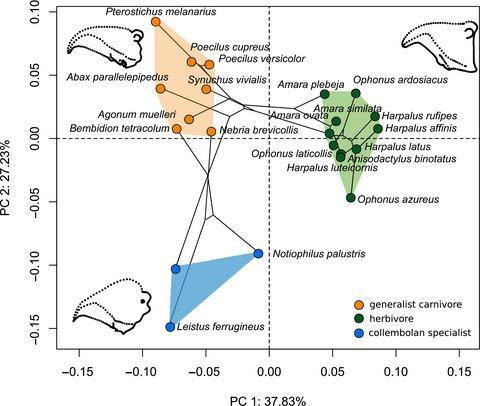当前位置:
X-MOL 学术
›
Ecol. Evol.
›
论文详情
Our official English website, www.x-mol.net, welcomes your feedback! (Note: you will need to create a separate account there.)
Convergent evolution of specialized generalists: Implications for phylogenetic and functional diversity of carabid feeding groups
Ecology and Evolution ( IF 2.6 ) Pub Date : 2020-10-11 , DOI: 10.1002/ece3.6746 Dennis Baulechner 1 , Frank Jauker 1 , Thomas A. Neubauer 1, 2 , Volkmar Wolters 1
中文翻译:

专业通才的融合发展:对甲鱼喂养群体系统发育和功能多样性的影响
更新日期:2020-10-29
Ecology and Evolution ( IF 2.6 ) Pub Date : 2020-10-11 , DOI: 10.1002/ece3.6746 Dennis Baulechner 1 , Frank Jauker 1 , Thomas A. Neubauer 1, 2 , Volkmar Wolters 1
Affiliation

|
- Closely related species are often assumed to be functionally similar. Phylogenetic information is thus widely used to infer functional diversity and assembly of communities. In contrast, evolutionary processes generating functional similarity of phylogenetically distinct taxa are rarely addressed in this context.
- To investigate the impact of convergent evolution on functional diversity (FD) and phylogenetic diversity (PD), we reconstructed the phylogenetic structure of carabid trophic groups. We then analyzed the mandible shapes using geometric morphometrics to link specialization in functional morphology with feeding specialization among herbivores, generalist carnivores, and specialized consumers of Collembola.
- Our results show that carabid feeding groups are paraphyletic. Herbivory evolved at least twice and specialization to Collembola predation at least three times. Species within feeding groups share a remarkably similar mandible morphology, which evolved convergently. While specialized mandibles of herbivores and collembolan specialists represent an adaptation to their main food source, the particular mandible morphologies do not necessarily reflect the degree of food specialization within feeding groups. Only a few species with a specialized herbivorous mandible may occasionally feed on animals, but the range of specific food resources in generalist carnivore species is large, despite an almost identical mandible shape.
- Thus, convergent evolution in specialized feeding groups reverses the relationship between PD and functional similarity compared with generalist carnivores. We conclude that phylogenetic relationship is a poor proxy of FD in carabids. Moreover, the inconsistencies between relatedness, morphological adaptation, and ecological function require caution in the characterization of functional groups. Rather than assuming general relationships between PD and FD, we suggest integrating the analysis of evolutionary processes into functional community analyses.
中文翻译:

专业通才的融合发展:对甲鱼喂养群体系统发育和功能多样性的影响
- 通常认为密切相关的物种在功能上相似。因此,系统发育信息被广泛用于推断功能多样性和社区的聚集。相反,在这种情况下,很少讨论产生系统发育上不同的类群功能相似性的进化过程。
- 为了研究趋同进化对功能多样性(FD)和系统发育多样性(PD)的影响,我们重建了营养级分子的系统发育结构。然后,我们使用几何形态计量学分析了下颌骨的形状,以将功能形态学的专业化与食草动物,通才食肉动物和Collembola的专门消费者之间的进食专业化联系起来。
- 我们的研究结果表明,甲级喂养组是寄生的。草食动物至少进化了两次,专业化捕食Collembola的过程至少进化了三次。饲喂组中的物种具有非常相似的下颌形态,它们的进化趋于一致。尽管食草动物的专业下颌骨和collembolan专家代表了对他们主要食物来源的适应,但特定的下颌骨形态并不一定反映喂养组内食物的专业化程度。仅有少数具有特殊草食性下颌骨的物种偶尔会以动物为食,尽管通体食肉动物的下颌形状几乎相同,但在其广泛的食肉动物物种中,特定食物资源的范围很大。
- 因此,与普通食肉动物相比,专门喂养组的趋同进化逆转了PD和功能相似性之间的关系。我们得出的结论是,亲缘关系是FD FD的不良代表。此外,相关性,形态适应性和生态功能之间的不一致在官能团的表征中需要谨慎。我们建议不要将PD和FD之间的一般关系作为假设,而是建议将进化过程的分析整合到功能性社区分析中。



























 京公网安备 11010802027423号
京公网安备 11010802027423号